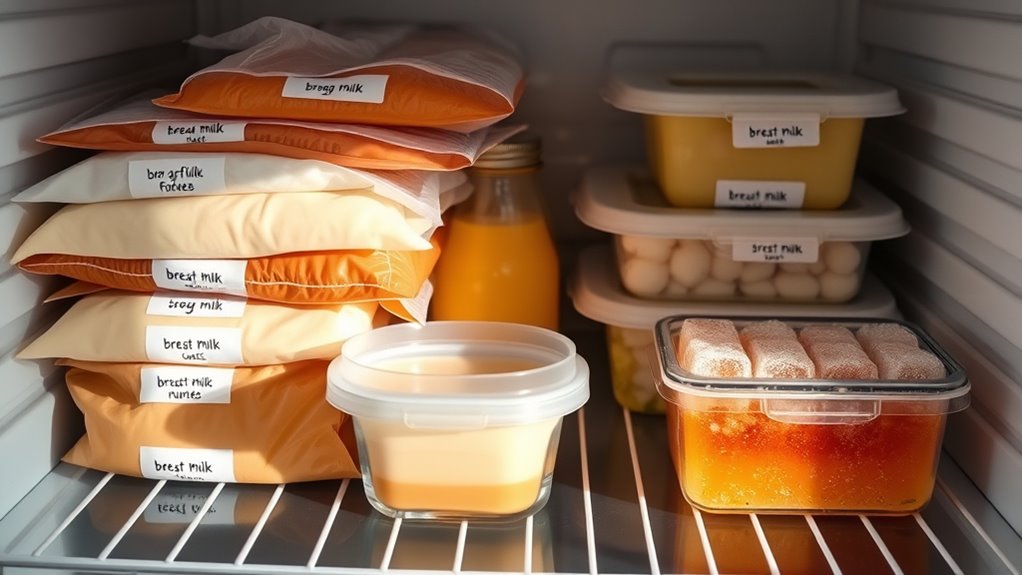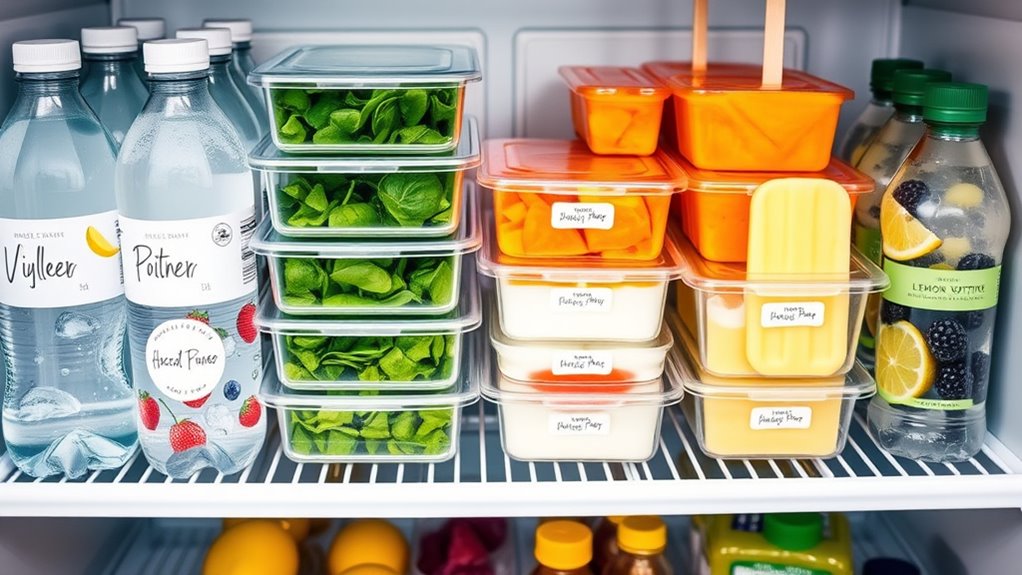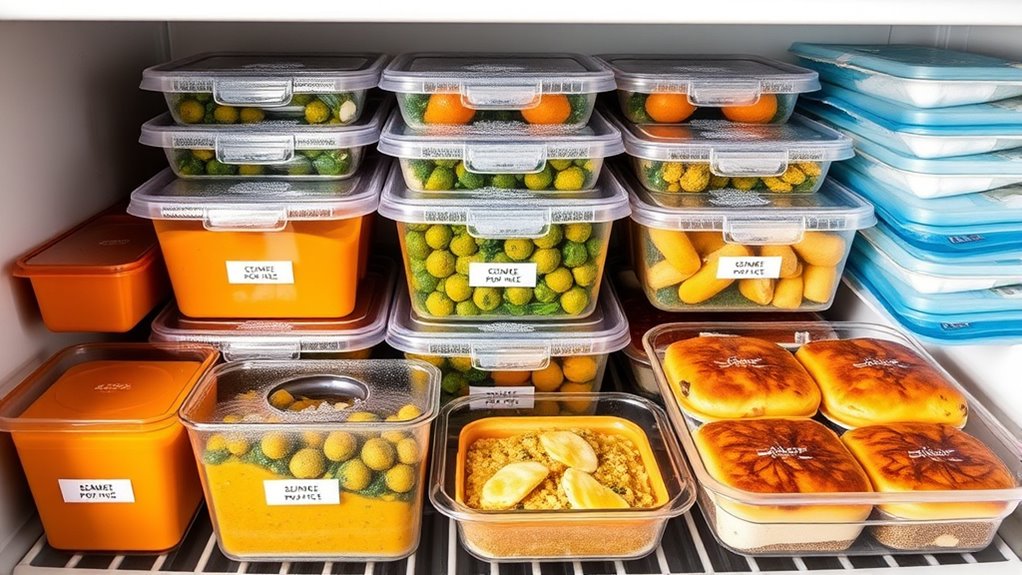Creating a postpartum freezer stash helps you save time and stay nourished during busy recovery weeks. Focus on planning nutritious, easy-to-reheat meals and snacks, using quality containers that prevent leaks and freezer burn. Label everything with dates, and organize your stash by batch or date for quick access. Proper storage, safe thawing, and regular inventory checks guarantee your food stays fresh and safe. Keep going to discover more tips for an efficient, nourishing postpartum freezer plan.
Key Takeaways
- Plan and select freeze-friendly, nutritious meals in advance, dividing into portions and labeling for freshness.
- Use proper storage containers like vacuum-sealed pouches or airtight containers to prevent leaks and freezer burn.
- Label all items with dates and contents, and organize the freezer by batch or date for easy access.
- Reheat meals gently in the fridge or warm water, avoiding microwaves to preserve nutrients and safety.
- Regularly check, rotate, and replenish your stash to ensure a safe, varied, and nutritious postpartum freezer supply.
Planning Your Freezer Meal Inventory

To make sure you have enough easy-to-prepare meals after giving birth, it’s vital to plan your freezer stash carefully. Start with meal planning by choosing recipes that freeze well and suit your dietary needs. Focus on portion control to prevent waste and make reheating easier. For example, divide large batches into single or double servings, so you can thaw only what you need. Label everything clearly with dates to keep track of freshness. Think about variety—include proteins, vegetables, and grains to guarantee balanced nutrition. Keep in mind that some meals reheat better than others, so prioritize those that maintain taste and texture after freezing. A well-thought-out plan will save you time and energy during those hectic postpartum days.
Essential Equipment and Storage Tips

To keep your freezer stash organized and accessible, you need effective storage solutions. Choosing the right containers and labeling everything clearly will save you time and confusion. Implementing smart organization strategies now guarantees your frozen milk stays fresh and easy to find later. Using storage containers that are specifically designed for freezing can help prevent leaks and freezer burn, ensuring your nourishment remains in optimal condition. Additionally, investing in vetted vacuum sealers can extend the shelf life of your milk by removing excess air and maintaining freshness. Incorporating automation in storage management can further streamline your process and keep track of your stash more efficiently.
Freezer Organization Strategies
Organizing your freezer stash is essential to keep your stored milk accessible and in good condition. Use clear storage containers designed for freezing breast milk to prevent spills and leaks. Invest in stackable bins or bins with lids to maximize space and keep different batches separate. Implement labeling techniques by writing the date and amount on each container with waterproof markers; this helps you use the oldest milk first and track your supply. Arrange containers in a way that allows easy access to the most recent or oldest milk, such as organizing by date or batch. Regularly check your stash for expired milk and rotate your stock to ensure freshness. A well-organized freezer saves time, reduces waste, and gives you peace of mind knowing your milk is stored safely. Additionally, understanding the importance of contrast ratio can help you select the best freezer environment for optimal preservation of your milk. Proper freezer temperature control is crucial to maintaining the quality and safety of your breast milk over time, and implementing storage best practices can further enhance milk longevity.
Suitable Container Options
Choosing the right containers is essential for keeping your breast milk fresh and protected. Reusable bags are a convenient option—durable, leak-proof, and easy to label. They save space in your freezer and reduce waste compared to disposable options. Vacuum sealers are another excellent choice; they remove air from storage bags or pouches, extending shelf life and preventing freezer burn. If you prefer traditional containers, look for BPA-free plastic or glass bottles with secure lids to prevent spills. Avoid thin-walled plastic or flimsy containers that can crack or leak. Whichever option you choose, ensure containers are clean, airtight, and appropriately sized for your daily feeding needs. Proper containers help maintain milk quality and simplify your postpartum nourishment routine. Additionally, selecting containers that are airtight and protect the integrity of the milk is crucial for preserving nutrients and preventing contamination. Using containers with airtight seals can further enhance freshness and safety. To ensure optimal preservation, always sanitize containers thoroughly before use to eliminate bacteria and odors.
Proper Labeling Techniques
Once you’ve selected the right containers for your breast milk, proper labeling guarantees your stash stays organized and safe. Follow labeling best practices by clearly marking each container with the date of expression and the type of milk. Use waterproof markers or pre-printed labels to prevent smudging. Include expiration date tracking to ensure you use the oldest milk first, reducing waste and maintaining freshness. Keep labels legible and consistent for easy identification. Store milk in small, manageable portions to avoid thawing more than needed. Regularly check labels and dates to stay on top of your freezer stash. Proper labeling not only keeps your stash organized but also ensures your baby receives safe, nutritious milk every time.
Choosing Nutrient-Rich Recipes

When selecting recipes for your postpartum freezer stash, focus on those that are packed with nutrients to support your recovery and energy needs. Nutrient-dense smoothies are excellent for quick, portable nourishment, blending fruits, vegetables, and protein sources like yogurt or nut butter. They’re easy to prepare in advance and freeze in individual portions. Hearty grain bowls also make a great option; fill them with whole grains, lean proteins, healthy fats, and colorful vegetables to boost your energy levels and aid healing. Look for recipes that use ingredients rich in vitamins, minerals, and antioxidants. Prioritize options that are satisfying and easy to reheat, ensuring you get essential nutrients without added effort during busy postpartum days. Choosing these nutrient-rich recipes helps you stay nourished and energized as you recover.
Batch Cooking and Assembly Strategies

To efficiently build your postpartum freezer stash, embrace batch cooking and assembly methods that save time and energy. These strategies streamline postpartum meal planning and provide quick nourishment during those busy days. Prepare large batches of versatile recipes like soups, stews, or casseroles, then portion and freeze them in individual servings for easy reheating. Incorporating breastfeeding support, choose nutrient-dense ingredients that boost milk production and recovery. Use these tips to maximize efficiency:
Batch cook and freeze nutritious, ready-to-heat meals for postpartum recovery and breastfeeding support.
- Cook in bulk and divide into single-serving containers
- Assemble ready-to-heat meals with pre-chopped ingredients
- Label and date all freezer items for quick identification
- Prepare themed meal kits for variety and simplicity
With these strategies, you’ll have nourishing options at your fingertips, making postpartum recovery and breastfeeding support more manageable.
Best Practices for Freezing and Thawing

Proper freezing and thawing are essential to preserve the quality, safety, and nutritional value of your postpartum freezer stash. When freezing, use airtight containers or freezer bags, leaving space for expansion, and label everything with dates. For thawing, your best thawing techniques involve slow refrigeration, which maintains safety and texture, or quick methods like using cold water or the microwave. Avoid thawing at room temperature, as it risks bacterial growth. When reheating, prioritize reheating safety by ensuring food reaches an internal temperature of 165°F (74°C). Stir or rotate foods during reheating to promote even heat distribution. Additionally, maintaining proper storage conditions helps prevent spoilage and preserves nutrients, ensuring your make-ahead nourishment stays fresh, safe, and nutritious, supporting your postpartum recovery without unnecessary stress or compromise. Understanding food safety protocols can further enhance your confidence in handling your freezer stash.
Sample Meal Ideas for Your Stash

Having a well-organized freezer stash makes mealtime easier during those busy postpartum days. To keep things simple, focus on versatile meals and snacks you can grab quickly. For example, prepare mini quiches or hearty vegetable soups that can be reheated easily. Snack combinations like cheese and crackers or yogurt with fruit are perfect for quick energy boosts. Smoothie recipes stored in individual portions make a nutritious, on-the-go option—just blend and enjoy. You can also freeze pre-portioned oatmeal cups or protein-packed muffins for convenience. These ideas help you stay nourished without extra effort, ensuring you always have nourishing options ready when time is limited. Keep your stash varied and easily accessible to support your recovery and new routines. Additionally, incorporating frozen meal planning strategies can help streamline your postpartum nutrition efforts.
Incorporating Snacks and Hydrating Options

Having quick, portable snacks on hand can keep your energy steady during busy days. Hydration boosters like infused water or electrolyte drinks help you stay refreshed and alert. Incorporating these options into your freezer stash makes nourishing yourself easier and more convenient. Choosing sustainable packaging for your snacks reduces waste and supports eco-friendly living. Additionally, selecting multi-functional furniture can help create more space for your food storage needs. Using efficient storage solutions can optimize your freezer space, making your make-ahead nourishment even more practical.
Portable Snack Ideas
When preparing your postpartum freezer stash, packing portable snacks and hydrating options guarantees you stay energized and refreshed throughout busy days. Having easy-to-grab foods helps prevent hunger and keeps your energy steady. Consider making a batch of healthy trail mix with nuts, dried fruit, and dark chocolate for a quick, nutritious snack. Energy bites made from oats, nut butter, and honey are perfect for on-the-go fueling. Wrap individual portions of dried fruit or trail mix in small containers or bags for convenience. Also, include hydrating options like infused water or electrolyte popsicles to keep hydration levels up. Incorporating hydration strategies such as electrolyte-rich drinks can further support your recovery. These simple, portable snacks and drinks will support your busy postpartum days, ensuring you stay nourished and energized without hassle.
Hydration Boosters
Packing portable snacks is a great way to keep your energy up, but staying hydrated is just as important. Incorporate herbal infusions like chamomile or peppermint into your water for a soothing, flavorful boost. These infusions can help keep you calm and refreshed during busy days. Electrolyte drinks are another excellent option, replenishing minerals lost during breastfeeding or physical activity. Look for low-sugar varieties or make your own with natural ingredients like sea salt, lemon, and honey. Carry a reusable water bottle with these hydration options so you can sip throughout the day without fuss. Staying well-hydrated supports your recovery, boosts energy, and helps maintain milk supply. Combining herbal infusions and electrolyte drinks ensures you stay refreshed and energized during your postpartum journey. Understanding city dynamics can help you better navigate your new environment and find local resources to support your recovery and daily needs. Additionally, being aware of personal finance management strategies like budgeting for health-related expenses can help you plan for ongoing postpartum needs. Incorporating Glycolic Acid Benefits for Skin into your skincare routine can also promote healing and skin renewal during this period.
Maintaining Your Freezer Stash Over Time

To guarantee your freezer stash stays fresh and safe to use over time, it’s essential to store your breast milk properly and check its condition regularly. Keep your milk in small, clearly labeled portions, and use the oldest first to prevent waste. Incorporate your freezer stash into your meal prep routines to ensure nutritional balance in your postpartum diet. Consistently monitor the storage temperature, ideally at 0°F (-18°C), to maintain milk quality. Thaw frozen milk slowly in the fridge or warm water, avoiding microwave heating. Regularly inspect milk for any signs of spoilage, like off smells or discoloration. Using proper storage techniques can help preserve your milk’s nutrients and ensure your baby’s nourishment remains safe and fresh over time.
Frequently Asked Questions
How Long Can Postpartum Freezer Meals Be Safely Stored?
You can safely store postpartum freezer meals for up to 3-6 months, depending on meal packaging and storage duration. Properly wrap or vacuum-seal your meals to prevent freezer burn and maintain freshness. Label each package with the date you froze it, so you know when to use it. For maximum quality, aim to consume meals within this timeframe, but they often stay safe beyond that if stored correctly.
What Are Common Mistakes to Avoid When Freezing Homemade Meals?
When freezing homemade meals, avoid common mistakes like skipping meal labeling and improper lid sealing. Always label your containers with the date and contents to prevent confusion and guarantee freshness. Make sure lids are sealed tightly to prevent freezer burn and leaks. These steps help maintain meal quality and safety, giving you peace of mind during those busy postpartum days, so you can focus on caring for your little one.
Can I Include Fresh Herbs in Freezer Meals Without Losing Flavor?
Fresh herbs can be a flavor bomb in your freezer meals, but they can fade like a whisper if you’re not careful. To keep their vibrant taste, use freezing tips like chopping herbs and packing them in airtight containers or ice cube trays with a bit of water or oil. This way, you preserve their aroma and flavor, ensuring every bite bursts with fresh herb goodness even after freezing.
How Do I Reheat Meals Without Compromising Nutritional Value?
You can reheat your freezer meals without losing nutritional value by using gentle reheating techniques. Opt for stovetop or oven methods over microwave, as they better preserve nutrients. Keep the temperature moderate and avoid overcooking. Cover dishes to retain moisture and nutrients. Stir occasionally to ensure even heating. These steps help maintain nutrient preservation, so your meals stay wholesome and nourishing even after reheating.
Are There Specific Containers Best Suited for Postpartum Meal Storage?
Think of your postpartum meal storage like a treasure chest—choose the right containers to keep your treasures fresh. Airtight containers are ideal because they prevent freezer burn and odors, while freezer-safe bags are perfect for saving space and labeling. I once used small glass containers, and they kept my meals fresh without spills. Stick with these options to guarantee your nourishment stays safe and delicious.
Conclusion
Building a postpartum freezer stash guarantees you have nourishing meals ready when you need them most. Did you know that new moms who prepare ahead report 30% less stress during recovery? By planning, choosing nutrient-rich recipes, and following best storage practices, you’ll create a reliable supply of wholesome food. This simple preparation not only supports your recovery but also helps you enjoy those precious early moments with your little one.









